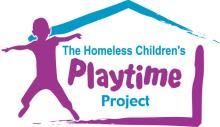
Serving families in Washington, D.C., The Homeless Children's Playtime Project reduces the traumatic effects of homelessness on children who live in temporary housing programs as well as promotes their physical and psychological development. They “protect a child's right to learn and heal through play by providing opportunities to simply be a child.”1 Besides offering weekly playtime activities for children and support activities for teens, they also advocate for affordable housing and safe shelters for families.2
Jamila Larson, a social worker, and Regina Kline, a lawyer,3 co-founded the Playtime Project in 2003 after visiting the largest homeless shelter in the country located just a few blocks away from the U.S. Capitol building. They discovered the grim reality of homelessness in which children were denied their right to a safe childhood.4 Previously, as a college student, Jamila had been successful in forming a children's play program in a Minneapolis homeless shelter.5 Together, Jamila and Regina saw that “a disproportionate number of children in shelters suffer from emotional, behavioral, and learning problems” and they felt the answer was play, which “is essential for children's cognitive, physical, and emotional well-being.”6
By creating child-safe places in family shelters and stocking the playrooms with toys and volunteers for play programs, the Playtime Project brings the benefits of play to children from infants to teens. One example of these benefits is on a physical level. The stress of being homeless releases the hormone cortisol, which affects the memory and thus the ability to learn at school. Exercise and “feelings of mastery” are two play experiences that produce serotonin, a hormone that negates the cortisol effect and restores the ability to retain knowledge.7
On an emotional level, the Playtime Project assists children to “build healthy relationships with caring adults and other children.”8 For this reason the volunteer staff is expected to make a commitment to supervise weekly play dates for a minimum of six months. During this time they plan and lead play curriculum activities, arts and crafts projects, reading times, imaginary play activities, and other games within a structure of order, safety, and respect.9
Other volunteer opportunities within the nonprofit Homeless Children's Playtime Project include adopting a playroom and its maintenance needs, hosting a holiday party, or sponsoring a drive for collecting needed supplies.
In 2009, Playtime Project created the Teen Program that involves academic tutoring and providing a place to “hang out” and receive peer support.10 Volunteers with the teen program also serve as mentors and facilitate a safe place for teen socializing and personal identity development.
That September, Jamila became Playtime Project's first full-time Executive Director. Housed at St. Stephen and the Incarnation Episcopal Church in Columbia Heights, Playtime Project coordinates eight weekly playtime and teen programs in five Washington, D.C. homeless shelters.11 They also produce a monthly newsletter and maintain an online resource center and blog for supporters and volunteers.
After becoming Director, Jamila summarized homeless children's needs and Playtime Project's effect: “When children first come to a shelter, (they are) traumatized, afraid to live in this institution. They leave their homes behind, their communities and their belongings. Here they feel welcome in a safe place to forget about stresses of being homeless for a little while.”12
- 1. “Mission.” The Homeless Children's Playtime Project. < http://www.playtimeproject.org/what-we-do/mission/ > 6 May 2013.
- 2. “What We Do.” The Homeless Children's Playtime Project. < http://www.playtimeproject.org/what-we-do/ > 6 May 2013.
- 3. Coronado, Kris. “Help homeless kids at the Playtime Project.” The Washington Post. December 22, 2011.< http://www.washingtonpost.com/goingoutguide/help-homeless-kids-at-the-playtime-project/2011/12/14/gIQARvPVBP_print.html > 12 May 2013.
- 4. “About.” The Homeless Children’s Playtime Project. < http://www.playtimeproject.org/about / > 21 May 2013.
- 5. “Board of Directors.” The Homeless Children's Playtime Project. < http://www.playtimeproject.org/about/board-of-directors/ > 16 May 2013.
- 6. “Why Play?” The Homeless Children's Playtime Project. < http://www.playtimeproject.org/what-we-do/why-play/ > 6 May 2013.
- 7. Yarrison, Mary. “Washingtonians of the Year 2012: Jamila Larson.” Washingtonian. January 14, 2013. < http://www.washingtonian.com/articles/people/washingtonians-of-the-year-2012-jamila-larson/ > 12 May 2013.
- 8. Op.cit., “Why Play?”
- 9. “Volunteer.” The Homeless Children's Playtime Project. < http://www.playtimeproject.org/get-involved/volunteer/ > 6 May 2013.
- 10. Op.cit., “What We Do.”
- 11. “Locations.” The Homeless Children's Playtime Project. < http://www.playtimeproject.org/what-we-do/locations/ > 12 May 2013.
- 12. Ceasar, Holly. “A Safe Place to Play.” Street Sense. 16 March 2011. < http://www.streetsense.org/2011/03/a-safe-place-to-play/ > 12 May 2013.

